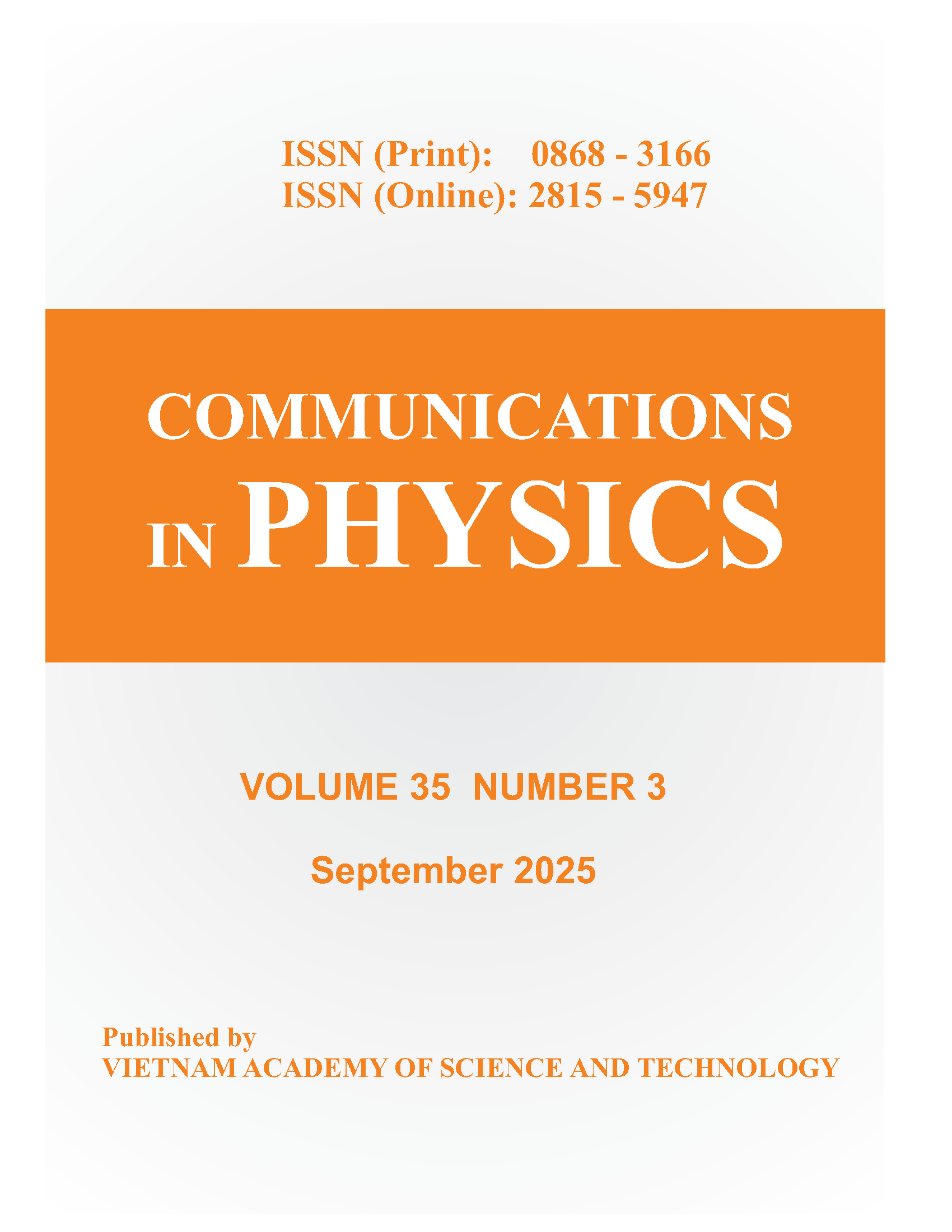Surface modification of nitrogen-doped carbon quantum dots for enhanced functionalities
Author affiliations
DOI:
https://doi.org/10.15625/0868-3166/21469Keywords:
Microplasma, nitrogen-doped carbon quantum dots, optical properties, surface modificationAbstract
A facile and controllable one-step atmospheric pressure microplasma method was employed to synthesize nitrogen-doped carbon quantum dots (N-CQDs) with tunable optical properties. The N-CQDs were characterized using Fourier transform infrared spectroscopy, high-resolution transmission electron microscopy, UV‒Vis absorption spectroscopy, and photoluminescence spectroscopy. HRTEM revealed uniformly distributed spherical nanoparticles with a graphite-like structure. FTIR confirmed effective nitrogen doping, enhancing chemical stability. UV‒Vis spectroscopy revealed redshifted absorption peaks, indicating improved electronic interactions and a reduced bandgap (4.05 eV) compared to those of undoped CQDs (4.18 eV). PL analysis revealed excitation-dependent emission and a significantly higher photoluminescence quantum yield (PLQY) of 33.09%. These results suggest that N-CQDs hold promise for applications in optoelectronics and bioimaging, providing a foundation for further optimization in future studies.
Downloads
References
. A. Kolanowska, G. Dzido, M. Krzywiecki, M.M. Tomczyk, D. Łukowiec, S. Ruczka, S. Boncel. - Carbon Quantum Dots from Amino Acids Revisited: Survey of Renewable Precursors toward High Quantum-Yield Blue and Green Fluorescence. ACS Omega, 7 (2022) 41165-41176. doi.org/10.1021/acsomega.2c04751.
B.K. John, T. Abraham, B. Mathew. - A Review on Characterization Techniques for Carbon Quantum Dots and Their Applications in Agrochemical Residue Detection. J. Fluoresc., 32 (2022) 449-471. doi.org/10.1007/s10895-021-02852-8.
S. Zhang, C. Xiao, H. He, Z. Xu, B. Wang, X. Chen, C. Li, B. Jiang, Y. Liu. - The adsorption behavior of carbon nanodots modulated by cellular membrane potential. Environ. Sci. Nano, 7 (2020) 880-890. doi.org/10.1039/c9en00991d.
K.A.S. Fernando, S. Sahu, Y. Liu, W.K. Lewis, E.A. Guliants, A. Jafariyan, P. Wang, C.E. Bunker, Y.P. Sun. - Carbon quantum dots and applications in photocatalytic energy conversion, ACS Appl. Mater. Interfaces, 7 (2015) 8363-8376. doi.org/10.1021/acsami.5b00448.
N.K. Stanković, M. Bodik, P. Šiffalovič, M. Kotlar, M. Mičušik, Z. Špitalsky, M. Danko, D.D. Milivojević, A. Kleinova, P. Kubat, Z. Capakova, P. Humpoliček, M. Lehocky, B.M. Todorović Marković, Z.M. Marković. - Antibacterial and Antibiofouling Properties of Light Triggered Fluorescent Hydrophobic Carbon Quantum Dots Langmuir-Blodgett Thin Films. ACS Sustain. Chem. Eng., 6 (2018) 4154-4163. doi.org/10.1021/acssuschemeng.7b04566.
Z.M. Marković, M. Kováčová, P. Humpolíček, M.D. Budimir, J. Vajďák, P. Kubát, M. Mičušík, H. Švajdlenková, M. Danko, Z. Capáková, M. Lehocký, B.M. Todorović Marković, Z. Špitalský. - Antibacterial photodynamic activity of carbon quantum dots/polydimethylsiloxane nanocomposites against Staphylococcus aureus, Escherichia coli and Klebsiella pneumoniae. Photodiagnosis Photodyn. Ther., 26 (2019) 342-349. doi.org/10.1016/j.pdpdt.2019.04.019.
X. Ma, S. Li, V. Hessel, L. Lin, S. Meskers, F. Gallucci. - Synthesis of luminescent carbon quantum dots by microplasma process. Chem. Eng. Process. Process Intensif., 140 (2019) 29-35. doi.org/10.1016/j.cep.2019.04.017.
S. Pandiyan, L. Arumugam, S.P. Srirengan, R. Pitchan, P. Sevugan, K. Kannan, G. Pitchan, T.A. Hegde, V. Gandhirajan. - Biocompatible Carbon Quantum Dots Derived from Sugarcane Industrial Wastes for Effective Nonlinear Optical Behavior and Antimicrobial Activity Applications. ACS Omega, 5 (2020) 30363-30372. doi.org/10.1021/acsomega.0c03290.
F. Zhao, X. Li, M. Zuo, Y. Liang, P. Qin, H. Wang, Z. Wu, L. Luo, C. Liu, L. Leng. - Preparation of photocatalysts decorated by carbon quantum dots (CQDs) and their applications: A review. J. Environ. Chem. Eng., 11 (2023) 109487. doi.org/10.1016/j.jece.2023.109487.
N. Arora, N.N. Sharma. - Arc discharge synthesis of carbon nanotubes: Comprehensive review. Diam. Relat. Mater., 50 (2014) 135-150. doi.org/10.1016/j.diamond.2014.10.001.
A.J. Clancy, M.K. Bayazit, S.A. Hodge, N.T. Skipper, C.A. Howard, M.S.P. Shaffer. - Charged Carbon Nanomaterials: Redox Chemistries of Fullerenes, Carbon Nanotubes, and Graphenes, Chem. Rev., 118 (2018) 7363-7408. doi.org/10.1021/acs.chemrev.8b00128.
X. Xu, R. Ray, Y. Gu, H. J. Ploehn, L. Gearheart, K. Raker, W. A. Scrivens. - Electrophoretic analysis and purification of fluorescent single-walled carbon nanotube fragments. J. Am. Chem. Soc., 126 (2004) 12736-12737. doi.org/10.1021/ja040082h.
Y. Hou, Q. Lu, J. Deng, H. Li, Y. Zhang. - One-pot electrochemical synthesis of functionalized fluorescent carbon dots and their selective sensing for mercury ion. Anal. Chim. Acta, 866 (2015) 69-74. doi.org/10.1016/j.aca.2015.01.039.
N. K. Quang, N. N. Hieu, V. V. Q. Bao, V. T. Phuoc, L. X. D. Ngoc, L. Q. Doc, N. M. Tri, L. V. T. Son, L. V. T. Son, C. T. C. Ha. - Hydrothermal synthesis of carbon nanodots from wine cork and biocompatible fluorescent probe. New Carbon Materials. 37 (2022) 595-602. doi.org/10.3762/bxiv.2021.45.v1.
Z. Sun, F. Yan, J. Xu, H. Zhang, L. Chen. - Solvent-controlled synthesis strategy of multicolor emission carbon dots and its applications in sensing and light-emitting devices. Nano Res., 15 (2022) 414-422. doi.org/10.1007/s12274-021-3495-8.
S.D. Dsouza, M. Buerkle, P. Brunet, C. Maddi, D.B. Padmanaban, A. Morelli, A.F. Payam, P. Maguire, D. Mariotti, V. Svrcek. - The importance of surface states in N-doped carbon quantum dots. Carbon N. Y., 183 (2021) 1-11. doi.org/10.1016/j.carbon.2021.06.088.
X. Dong, H. Qi, Z. Zhai, W. Li, P. Zhang. - Probing the fluorescence quenching mechanism of N-doped carbon quantum dots by inorganic ions. Microchem. J., 197 (2024). doi.org/10.1016/j.microc.2023.109854.
R. Shi, Z. Li, H. Yu, L. Shang, C. Zhou, G.I.N. Waterhouse, L.Z. Wu, T. Zhang. - Effect of Nitrogen Doping Level on the Performance of N-Doped Carbon Quantum Dot/TiO2 Composites for Photocatalytic Hydrogen Evolution. Chem. Sus. Chem., 10 (2017) 4650-4656. doi.org/10.1002/cssc.201700943.
Rishabh, M. Rani, U. Shanker, B. Singh Kaith, M. Sillanpää. - Green fabrication of fluorescent N-doped carbon quantum dots from Aegle marmelos leaves for highly selective detection of Fe3+ metal ions. Inorg. Chem. Commun., 159 (2024) 111878. doi.org/10.1016/j.inoche.2023.111878.
X. J. Jiang, Y. Ma, Y. Zhou, R.D. Xiao, Y. J. Meng, Ye-Hou, B. T. Xie, L. H. Wu, D. H. Zhao. - Green one-step synthesis of N-doped carbon quantum dots for fluorescent detection of lemon yellow in soft drinks. Spectrochim. Acta - Part A Mol. Biomol. Spectrosc., 316 (2024) 124305. doi.org/10.1016/j.saa.2024.124305.
X. Luo, P. Bai, X. Wang, G. Zhao, J. Feng, H. Ren. - Preparation of nitrogen-doped carbon quantum dots and its application as a fluorescent probe for Cr(vi) ion detection. New J. Chem., 43 (2019) 5488-5494. doi.org/10.1039/C8NJ06305B.
X. Qin, W. Lu, A.M. Asiri, A.O. Al-Youbi, X. Sun. - Microwave-assisted rapid green synthesis of photoluminescent carbon nanodots from flour and their applications for sensitive and selective detection of mercury(II) ions. Sensors Actuators. B Chem., 184 (2013) 156-162. doi.org/10.1016/j.snb.2013.04.079.
M. Fu, F. Ehrat, Y. Wang, K.Z. Milowska, C. Reckmeier, A.L. Rogach, J.K. Stolarczyk, A.S. Urban, J. Feldmann. - Carbon Dots: A Unique Fluorescent Cocktail of Polycyclic Aromatic Hydrocarbons, Nano Lett., 15 (2015) 6030-6035. doi.org/10.1021/acs.nanolett.5b02215.
Z. Yan, J. Shu, Y. Yu, Z. Zhang, Z. Liu, J. Chen. - Preparation of carbon quantum dots based on starch and their spectral properties. Luminescence, 30 (2015) 388-392. doi.org/10.1002/bio.2744.
P. Yang, Z. Zhu, T. Zhang, M. Chen, Y. Cao, W. Zhang, X. Wang, X. Zhou, W. Chen. - Facile synthesis and photoluminescence mechanism of green emitting xylose-derived carbon dots for anti-counterfeit printing. Carbon N. Y., 146 (2019) 636-649. doi.org/10.1016/j.carbon.2019.02.028.
M.H. Nguyen, D.T. Le, H.T. Do, A.T. Le. - Remarkable luminescent carbon quantum dots: green synthesis from orange juice using microplasma-liquid method. Fullerenes Nanotub. Carbon Nanostructures, 32 (2024) 282-287. doi.org/10.1080/1536383X.2023.2274917.
M. H. Nguyen, A. T. Le, V. D. Pham, H. M. Pham, H. T. Do, D. T. Le, T. B. Vu, T. B. Nguyen. - A Comprehensive Study on the Antibacterial Activities of Carbon Quantum Dots Derived from Orange Juice against Escherichia coli. Appl. Sci., 14 (2024) 51-66. doi.org/10.3390/app14062509.
X. Niu, Y. Li, H. Shu, J. Wang. - Revealing the underlying absorption and emission mechanism of nitrogen doped graphene quantum dots. Nanoscale, 8 (2016) 19376-19382. doi.org/10.1039/c6nr06447g.
G. S. Jamila, S. Sajjad, S. A. K. Leghari, Y. Li. - Pivotal role of N and Bi doping in CQD/Mn3O4 composite structure with outstanding visible photoactivity. New J. Chem., 44 (2020) 11631-11642. doi.org/10.1039/d0nj01457e.
Downloads
Published
How to Cite
Issue
Section
License
Communications in Physics is licensed under a Creative Commons Attribution-ShareAlike 4.0 International License.
Copyright on any research article published in Communications in Physics is retained by the respective author(s), without restrictions. Authors grant VAST Journals System (VJS) a license to publish the article and identify itself as the original publisher. Upon author(s) by giving permission to Communications in Physics either via Communications in Physics portal or other channel to publish their research work in Communications in Physics agrees to all the terms and conditions of https://creativecommons.org/licenses/by-sa/4.0/ License and terms & condition set by VJS.











